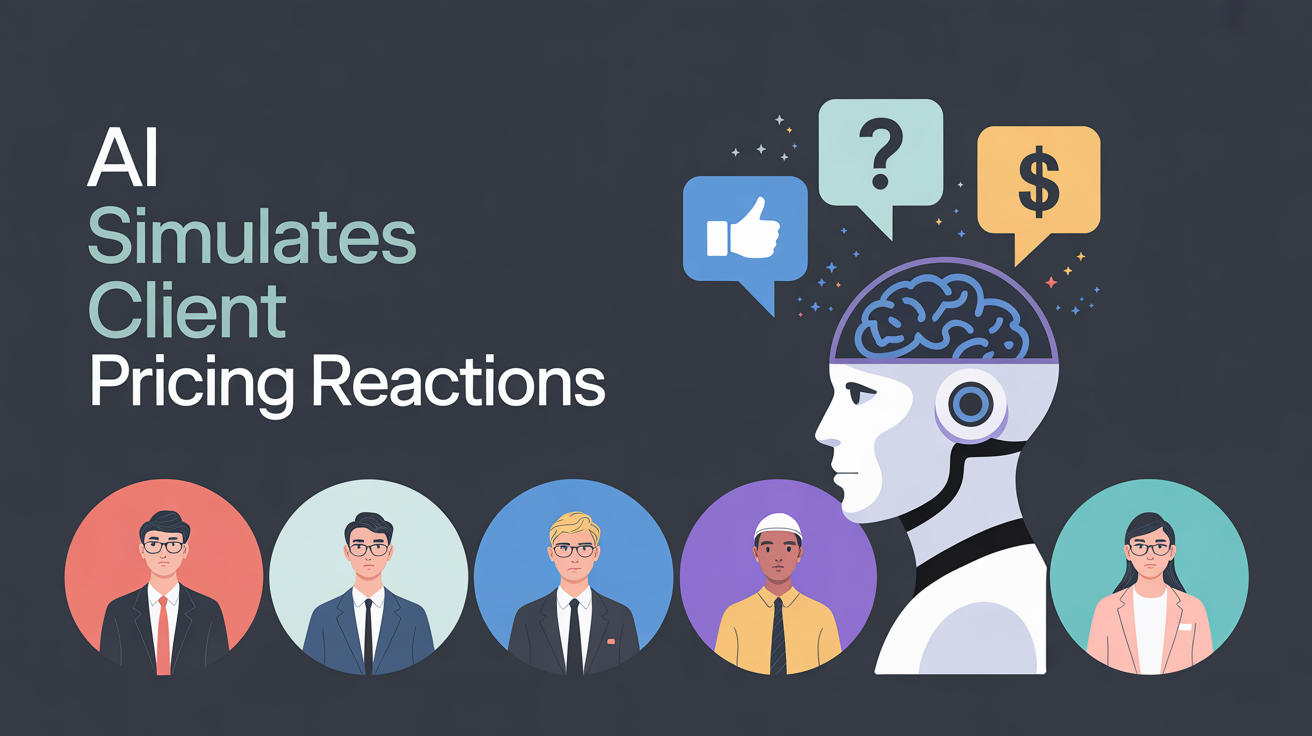Can AI Simulate A Client's Reaction To My Pricing Proposal?
AI Tools • Oct 6, 2025 1:35:53 PM • Written by: Kelly Kranz

Yes. AI can simulate client reactions to pricing proposals by acting as specific buyer personas. The key is providing detailed persona information including budget constraints, pain points, and decision-making criteria to generate realistic feedback on your pricing structure and presentation (Clearvoice).
Frequently Asked Questions
Can AI simulate client reactions to pricing proposals?
Yes, AI can simulate client reactions to pricing proposals by creating specific buyer personas and using them to generate realistic feedback on pricing structures and presentations.
What are the core components of AI pricing simulation?
The core components of AI pricing simulation include persona development, proposal testing, and reaction analysis. This helps in understanding client perspectives on pricing before actual meetings.
What are the benefits of AI-driven pricing feedback?
AI-driven pricing feedback helps in detecting immediate objections such as budget misalignment and value perception gaps, providing a risk reduction strategy by preparing for objections, developing counter-arguments, and creating pricing tiers based on feedback.
How do you implement AI pricing simulation?
To implement AI pricing simulation, start by building accurate client personas, submit pricing materials for testing, and analyze feedback patterns to identify common objections and areas of confusion that need to be addressed in pricing strategies.
How AI Pricing Simulation Works
The Basic Process
AI pricing simulation involves three core components:
- Persona development - Creating detailed client profiles with specific budget parameters.
- Proposal testing - Submitting your pricing materials for virtual client review.
- Reaction analysis - Receiving detailed feedback on pricing perception and objections.
The AI Marketing Automation Lab's Buyers Table system streamlines this process by maintaining pre-built buyer personas that include budget sensitivity, purchasing authority, and industry-specific cost expectations. This eliminates the guesswork in pricing conversations before they happen.
What Makes Simulation Effective
Effective pricing simulation requires personas with:
- Specific budget ranges and approval processes.
- Industry benchmarks and cost expectations.
- Past purchasing decisions and price sensitivity patterns.
- Role-based concerns (CFO vs. end-user perspectives).
Key Benefits of AI Pricing Feedback
Immediate Objection Detection
AI simulation reveals common pricing objections before client meetings:
- Budget misalignment - When your pricing exceeds typical industry ranges.
- Value perception gaps - Where clients don't see justification for your rates.
- Competitive positioning issues - How your pricing compares to alternatives.
- Payment structure concerns - Problems with terms, timing, or structure.
The Buyers Table system excels here by providing multiple stakeholder perspectives. A CFO persona might focus on ROI calculations, while an operations manager might prioritize implementation costs and timeline. This is particularly evidence of how AI enhances preparation for client objections and meeting readiness.
Risk Reduction Strategy
Testing pricing proposals through AI simulation provides:
- Confidence in client meetings - Know potential pushback in advance.
- Prepared responses - Develop counter-arguments for common objections.
- Alternative options - Create pricing tiers based on simulated feedback.
- Negotiation boundaries - Understand where flexibility helps vs. hurts.
Practical Implementation Steps
Step 1: Build Accurate Client Personas
Create detailed profiles including:
- Company size and typical budget ranges.
- Decision-making process and approval levels.
- Previous vendor experiences and pricing expectations.
- Industry-specific cost sensitivities and benchmarks (Harvard Business).
Step 2: Submit Your Pricing Materials
Test various pricing elements:
- Complete proposals - Full pricing presentations with justifications.
- Rate sheets - Standalone pricing without context.
- Package comparisons - Multiple tier options.
- Payment terms - Different structure alternatives.
Step 3: Analyze Feedback Patterns
Look for recurring themes in AI responses:
- Consistent objection points across personas.
- Positive reactions to specific value propositions.
- Confusion about pricing structure or terms.
- Requests for additional information or alternatives.
Advanced Pricing Simulation Techniques
Multi-Stakeholder Analysis
The Buyers Table system allows testing against complete buying committees:
- Economic buyer reactions to overall investment levels.
- Technical buyer responses to implementation costs.
- End user concerns about ongoing expenses.
- Influencer feedback on competitive positioning.
Scenario Testing
Run multiple pricing scenarios to optimize your approach:
- Premium positioning - Test higher rates with enhanced value props.
- Competitive matching - Evaluate market-rate pricing reception.
- Value-based tiers - Assess different service level responses.
- Custom packages - Validate tailored pricing approaches.
Industry-Specific Calibration
Different industries require different simulation approaches:
- Enterprise clients - Focus on ROI, compliance, and scalability costs.
- Small business - Emphasize affordability and quick payback.
- Government/non-profit - Address budget constraints and approval processes.
- Startups - Balance growth potential with current limitations.
Common Pricing Simulation Mistakes
Insufficient Persona Detail
Generic buyer personas produce generic feedback. Effective pricing simulation requires:
- Specific budget parameters, not broad ranges.
- Actual decision-making authority levels.
- Real industry benchmarks and competitive context.
- Historical purchasing patterns and preferences.
Over-Reliance on Single Perspectives
Testing pricing against only one persona type misses critical dynamics:
- Financial decision-makers vs. operational stakeholders.
- Different risk tolerance levels across roles.
- Varying timeline pressures and urgency factors.
- Distinct value perception priorities.
Ignoring Implementation Context
Pricing doesn't exist in isolation. Effective simulation considers:
- Timing factors - Budget cycles, urgent needs, planning horizons.
- Competitive landscape - Alternative options and market conditions.
- Relationship dynamics - New vs. existing client considerations.
- Economic environment - Current market conditions and constraints.
Measuring Simulation Accuracy
Validation Checkpoints
Track how AI predictions compare to real client reactions:
- Objection accuracy - Do simulated concerns match actual pushback?
- Acceptance patterns - Are positive AI responses confirmed in practice?
- Negotiation points - Do predicted negotiation areas materialize?
- Decision timelines - How well does AI predict approval processes?
Continuous Improvement
Refine your simulation approach based on results:
- Update persona details with new client information.
- Adjust budget parameters based on actual client data.
- Incorporate feedback from recent pricing conversations.
- Test new pricing strategies before market implementation.
Integration with Sales Strategy
Pre-Meeting Preparation
Use AI pricing simulation to:
- Anticipate questions - Prepare responses for likely concerns.
- Develop alternatives - Create backup pricing options.
- Practice responses - Role-play objection handling.
- Set negotiation boundaries - Know your flexibility limits.
Proposal Customization
Tailor pricing presentations based on simulation insights:
- Emphasize value points - Highlight aspects that resonated with AI personas.
- Address concerns proactively - Build objection responses into initial proposals.
- Structure for clarity - Present pricing in formats that tested well.
- Provide context - Include justifications that reduced AI resistance.
The AI Marketing Automation Lab's Buyers Table system transforms pricing strategy from guesswork into data-driven decision-making. By simulating client reactions before real conversations, you can approach pricing discussions with confidence, prepared responses, and optimized proposals that significantly improve acceptance rates.
This systematic approach to pricing validation helps sales teams close deals faster, reduce negotiation cycles, and maintain healthier profit margins through better-informed pricing strategies.
Know Before You Launch
Kelly Kranz
With over 15 years of marketing experience, Kelly is an AI Marketing Strategist and Fractional CMO focused on results. She is renowned for building data-driven marketing systems that simplify workloads and drive growth. Her award-winning expertise in marketing automation once generated $2.1 million in additional revenue for a client in under a year. Kelly writes to help businesses work smarter and build for a sustainable future.

